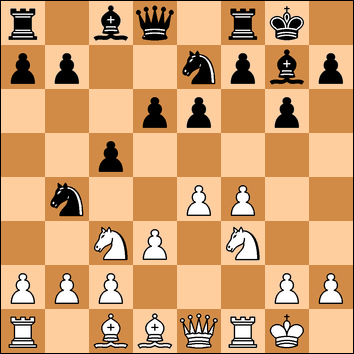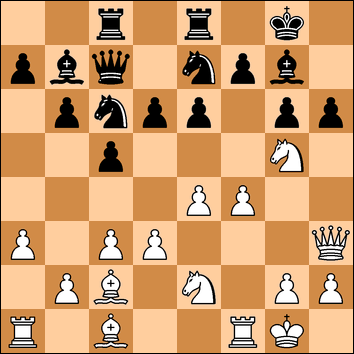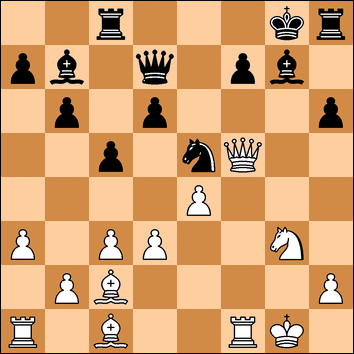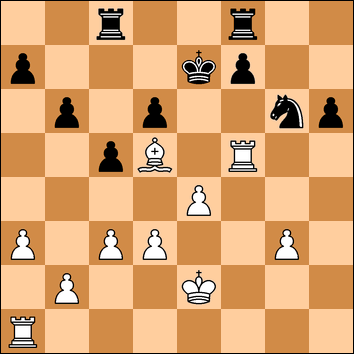Swale Club Chess Championship - Final Group - Round Four
Thursday 30 May 2019
White: Keith Nevols (163) - Black: David Page (143)
Sicilian Defence
A must-win game as my opponent was a long way ahead of me in the championship.
1. e4 c5
2. Nc3 d6
3. f4 g6
4. Nf3 Bg7
5. Be2 Na6!?
A curious deployment of the knight. Playing Nc6 and possibly Nd4 is more common.
6. Bxa6 bxa6 opens the b-file for possible counterplay for Black, and I thought giving up the bishop was not worth this.
A curious deployment of the knight. Playing Nc6 and possibly Nd4 is more common.
6. Bxa6 bxa6 opens the b-file for possible counterplay for Black, and I thought giving up the bishop was not worth this.
6. O-O e6
7. Qe1
Pressing ahead with 7. e5 - exploiting the lack of a black knight on c6 - keeps an edge but I did not like this option until I was more developed. Nor did I want to allow him the f5 square for the king's knight.
The engine recommends 7. d4 converting to an open Sicilian where the a6 knight does not look so good.
7. ….. Nb4
Pressing ahead with 7. e5 - exploiting the lack of a black knight on c6 - keeps an edge but I did not like this option until I was more developed. Nor did I want to allow him the f5 square for the king's knight.
The engine recommends 7. d4 converting to an open Sicilian where the a6 knight does not look so good.
7. ….. Nb4
8. Bd1 Ne7
9. d3 O-O

The position is now equal. White could consider a pawn sacrifice with 10. e5 Nbc6 (10. . dxe5 11. fxe5 Nbc6 12. Bg5 looks quite good) and then 11. Ne4!? dxe5 12. fxe5 Nxe5 13. Nxe5 Bxe5 14. c3 Qc7 15. Nf6+ Bxf6 16. Rxf6. For the price of a pawn, the black squared bishop has gone and White might have some play on the kingside.
10. a3?!
After making this move, I did not like it. It forces the knight where it will be going anyway, and as I usually play pawn to c3 in this system (both to block the long diagonal and protect the d4 square), the a3 move weakens the queenside with a few holes.
10. …. Nbc6
The position is now equal. White could consider a pawn sacrifice with 10. e5 Nbc6 (10. . dxe5 11. fxe5 Nbc6 12. Bg5 looks quite good) and then 11. Ne4!? dxe5 12. fxe5 Nxe5 13. Nxe5 Bxe5 14. c3 Qc7 15. Nf6+ Bxf6 16. Rxf6. For the price of a pawn, the black squared bishop has gone and White might have some play on the kingside.
10. a3?!
After making this move, I did not like it. It forces the knight where it will be going anyway, and as I usually play pawn to c3 in this system (both to block the long diagonal and protect the d4 square), the a3 move weakens the queenside with a few holes.
10. …. Nbc6
11. Qg3
I often play this move to place the queen on the same file as the king. The effect is more illusionary than real. Black continues to develop his queenside.
11. …. b6
I often play this move to place the queen on the same file as the king. The effect is more illusionary than real. Black continues to develop his queenside.
11. …. b6
12. Ne2 Bb7
13. c3 Rc8
13. .. d5 is more energetic. I might have replied with 14. Bc2 but Black has the initiative in this position.
14. Bc2 Qc7
13. .. d5 is more energetic. I might have replied with 14. Bc2 but Black has the initiative in this position.
14. Bc2 Qc7
15. Qh3
I want to create some weaknesses around his King.
15. ….. Rfe8
I want to create some weaknesses around his King.
15. ….. Rfe8
16. Ng5 h6

My initial plan was to bring the knight back to f3 with a job done, but now I saw two other options involving sacrificing the knight.
I looked at 17. Nxf7!? Kxf7 18. f5 exf5 19. gxf5 Nxf5 and did not see the follow up 20. Bb3+ which gets a strong attack. Here 20. .. Kf8 meets 21. Nf4 threatening mate in one and 20... Ke7 21. Nf4 Ne5 22. Ne6 (on 22. Nxg6 Nxg6 23. Qxf5 Black can hold with 23. …. Ne5 24. d4 cxd4 25. cxd4 Kd8! 26. dxe5 Rxe5) where Black will have to try 22. .. Qc6 23. Nxg7 Nxg7 24. Bxh6 Qxg2+ returning the piece.
I also looked at 17. f5!? exf5 18. Nxf7 Kxf7 19. exf5 Nxf5 which transposes.
In the end, being unable to see anything definite, and aware that I was not too strong on tactics, I remained cautious.
17. Nf3 Kh7
Handily placing the king on the same diagonal as my bishop. 17. .. f5 was the move I feared, and I now moved to prevent it.
18. g4
The immediate 18. f5 exf5 19. Ng3 is another interesting pawn sacrifice.
18. …... Rh8
A solid move but 18. .. d5 hitting back in the centre is an improvement.
19. f5!
At last!
19. ..... exf5
My initial plan was to bring the knight back to f3 with a job done, but now I saw two other options involving sacrificing the knight.
I looked at 17. Nxf7!? Kxf7 18. f5 exf5 19. gxf5 Nxf5 and did not see the follow up 20. Bb3+ which gets a strong attack. Here 20. .. Kf8 meets 21. Nf4 threatening mate in one and 20... Ke7 21. Nf4 Ne5 22. Ne6 (on 22. Nxg6 Nxg6 23. Qxf5 Black can hold with 23. …. Ne5 24. d4 cxd4 25. cxd4 Kd8! 26. dxe5 Rxe5) where Black will have to try 22. .. Qc6 23. Nxg7 Nxg7 24. Bxh6 Qxg2+ returning the piece.
I also looked at 17. f5!? exf5 18. Nxf7 Kxf7 19. exf5 Nxf5 which transposes.
In the end, being unable to see anything definite, and aware that I was not too strong on tactics, I remained cautious.
17. Nf3 Kh7
Handily placing the king on the same diagonal as my bishop. 17. .. f5 was the move I feared, and I now moved to prevent it.
18. g4
The immediate 18. f5 exf5 19. Ng3 is another interesting pawn sacrifice.
18. …... Rh8
A solid move but 18. .. d5 hitting back in the centre is an improvement.
19. f5!
At last!
19. ..... exf5
20. gxf5 Kg8
21. Nh4?
Missing both 21. fxg6 (if 21. …. fxg6 22. Qe6+ Kh7 23. Bxh6! which will mate after 23. … Bxh6 24. Ng5+ Bxg5 25. Rf7+) 21. …Nxg6 22. Ng3 and 21. Nf4.
21. .....gxf5?
Black in turn misses 21. .. Qd7! and slightly weakens the cover of his king.
22. Nxf5?
Better is 22. exf5 keeping the knight on and keeping a threat of f6.
22. …. Nxf5
Missing both 21. fxg6 (if 21. …. fxg6 22. Qe6+ Kh7 23. Bxh6! which will mate after 23. … Bxh6 24. Ng5+ Bxg5 25. Rf7+) 21. …Nxg6 22. Ng3 and 21. Nf4.
21. .....gxf5?
Black in turn misses 21. .. Qd7! and slightly weakens the cover of his king.
22. Nxf5?
Better is 22. exf5 keeping the knight on and keeping a threat of f6.
22. …. Nxf5
23. Qxf5 Ne5
This knight is well placed. White cannot play 24. d4 cxd4 25. cxd4 due to the loose bishop on c2.
This knight is well placed. White cannot play 24. d4 cxd4 25. cxd4 due to the loose bishop on c2.
24. Ng3 Qd7
Running out of ideas, I decide to cash in and see if I can make anything of a better endgame.

25. Bf4 Qxf5
Running out of ideas, I decide to cash in and see if I can make anything of a better endgame.
25. Bf4 Qxf5
26. Nxf5 Rd8
27. Kf2 Bc8
At this point, Black offered a draw. Needing a win, and thinking I was still better, I decided to play on. And that bishop can go for a start.
28. Ne7+ Kf8
At this point, Black offered a draw. Needing a win, and thinking I was still better, I decided to play on. And that bishop can go for a start.
28. Ne7+ Kf8
29. Nxc8 Rxc8
30. Ke2
Protecting d3 so that I can liberate the white squared bishop for other duties.
30. …. Ke7
Protecting d3 so that I can liberate the white squared bishop for other duties.
30. …. Ke7
31. Bb3 Rhf8
32. Bd5 Ng6
33. Bg3 Be5
34. Rf5 Bxg3
35. hxg3

Now down to my last five minutes, I stopped writing down the moves.
The endgame battle began, and I managed to use my slight positional advantage to win a pawn. Exchanges went all the way down to a rook and d-pawn v rook ending but thankfully I managed to cut his king off from the pawn.
We went into what is known as the Lucena position, and at one stage I invested a few seconds to remind myself how to win that position, which I was able to. A good victory over a tough opponent.
Now down to my last five minutes, I stopped writing down the moves.
The endgame battle began, and I managed to use my slight positional advantage to win a pawn. Exchanges went all the way down to a rook and d-pawn v rook ending but thankfully I managed to cut his king off from the pawn.
We went into what is known as the Lucena position, and at one stage I invested a few seconds to remind myself how to win that position, which I was able to. A good victory over a tough opponent.